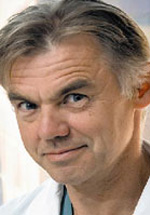 There was no ‘ah-ha’ moment or a single person to take credit for a life changing procedure which has saved the lives of thousands around the world, but there was one alumnus from UBC’s Faculty of Medicine who lead a team of individuals through a series of incremental steps to pioneer percutaneous heart valve replacement; a lifesaving, non-invasive procedure to replace the aortic valve in individuals who do not qualify for open heart surgery.
There was no ‘ah-ha’ moment or a single person to take credit for a life changing procedure which has saved the lives of thousands around the world, but there was one alumnus from UBC’s Faculty of Medicine who lead a team of individuals through a series of incremental steps to pioneer percutaneous heart valve replacement; a lifesaving, non-invasive procedure to replace the aortic valve in individuals who do not qualify for open heart surgery.
John Webb, born and raised in Vancouver, BC, graduated from UBC Faculty of Medicine’s MD program in 1982 and is now an interventional cardiologist at St. Paul’s Hospital. Growing up he had a strong interest in biology and started his undergraduate life studying this field at Simon Fraser University and Capilano College. Growing up with a father who specialized in obstetrics, Webb had seen firsthand the hours and responsibility of a doctor and medicine was not his initial choice for a career. However, his interest in biology and having an impact on other people’s lives drew him to medical school. The heart became his fascination as it was a moveable part which could be held in the hand and fixed.
Webb interned for one year at the University of Toronto and then returned to Vancouver as an internal medicine resident for two years. He was soon offered a 2 year cardiology fellowship in Toronto and then spent another two years as a Canadian Heart Foundation fellow in San Francisco at the University of California. The sun and sand wasn’t enough to keep Webb south and he soon returned to Vancouver where he began his incredible career at St. Paul’s Hospital.
Webb and his team developed the percutaneous heart valve replacement procedure used today in 2005. A compressed valve, made of cow tissue, is sewn to a circular mesh stent. This stent can expand and collapse with ease and in its compact form has a diameter no larger than a few millimeters.
The stent is threaded through the femoral artery in the leg behind a small balloon on a catheter. Once in the desired position of the aortic valve, the stent is then pulled over the balloon and is prepared for expansion. The stent expands when salt water fills the balloon and forces the metal mesh frame open to fit snugly against the existing valve. The balloon is then deflated and the flaps of the artificial valve begin to pump open and closed with blood flow.
This innovative method is a remarkable alternative procedure for people who are unable to undergo open heart surgery due to age or other health risks. It is a minimally invasive procedure with successful results, shorter recovery time, and, most importantly, gives life back to those who could not have or were at very high risk with traditional surgery.
With more than 500 successful procedures having been performed at St. Paul’s Hospital, Webb and his team are now training doctors across North America, Europe and Australia. Webb knows the importance of sharing this discovery with other medical professionals worldwide and spends much of his time travelling the globe teaching and overseeing this procedure being done.
Recently, St. Paul’s Hospital installed a new Virtual Teaching Laboratory, which allows Webb to offer real-time broadcasts and two way communication of the percutaneous heart valve replacement. This gives him more time to continue his research quest in transcatheter management of structural and valvular disease and new device development, but still allows him to continue educating colleagues with this technique.
While Webb has made medical history developing this procedure, he is modest and believes that his greatest life’s achievement is his family. Spending time with his family and living an active lifestyle is what is most important. Webb met his wife, Jennifer, in high-school and later had two sons, one who now lives in Vancouver and the other who lives in Montreal. In keeping up with his own cardiac health activity and with the support of his family, Webb hopes to complete a Grand Fondo race this summer.
Comments are closed, but trackbacks and pingbacks are open.